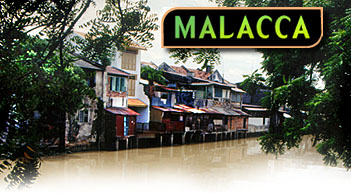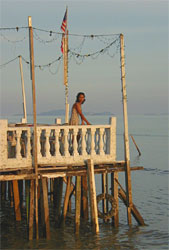Kuala Lumpur (translated as: "muddy confluence" or "muddy estuary"; pronounced /ˈkwɑːləlʊmˈpʊər/ in English;[3] Malay [kwɑlɑlʊmpʊ], locally [kwɑləlʊmpɔ],[4] and often abbreviated as K.L.) is the capital and the largest city of Malaysia in terms of population.[5] The city proper, making up an area of 244 km2 (94 sq mi), has an estimated population of 1.6 million in 2006.[6] Greater Kuala Lumpur, also known as the Klang Valley, is an urban agglomeration of 7.2 million.[7] It is the fastest growing metropolitan region in the country, in terms of population and economy.
 | ||
Kedah has the distinction of being the "Rice-bowl of Malaysia" - a term that takes on aesthetic significance when one sees the rice fields for themselves: the flat expanse of padis against a backdrop of rolling hills provides a picture of utter serenity that lulls the senses.
Off Kedah's western shores are clusters of sun-drenched islands that comprise the legendary archipelago of Langkawi, easily the most popular resort location in the country. More than a land of mere scenery, however, Kedah is also the site of Malaysia's most extensive ruins. In the Bujang Valley are the sprawling remains of a Hindu kingdom believed to date back to the 6th century A.D.
Like Malaysia's other states, Kedah has its share of rich cultural traditions, songs and dances. Due to its close proximity to Thailand, some of these traditions are Thai in influence and origin, and faces of Kehah's people often bear signs of Thai or Achinese ancestry
Like Kelantan and Pahang, Perak is a state that is defined by the course of its namesake river. Perak's population is about two million. Until the nineteenth century, Perak's people were concentrated along the Perak River, and the chief city was riverside Kuala Kangsar. However, the discovery of wondrously rich tin deposits in surrounding valleys lead to the establishment of and transfer of the capital to Taiping and, later, Ipoh. The tin mines around Ipoh are reputedly the richest in the world, and it is no surprise that the city has expanded steadily from the time the mines were discovered in the nineteenth century. Today, Ipoh is one of Malaysi
Like Sabah, Sarawak is known to international visitors primarily because of the extraordinary natural wonders of its national parks, including Gunung Mulu, the Niah Caves, and Bako. Sarawak's cultural treasures are also fascinating, reflecting the influence not only of the state's many ethnic peoples, but also the odd western influence of Sarawak's "White Rajahs."
The capital of Sarawak is Kuching. Malaysia Airlines flies regularly to Kuching International Airport as well as to Miri from Kuala Lumpur, Johor Bahru, Singapore, and Kota Kinabalu. Boats are a common mode of transport in Sarawak, as its the dense vegetation of its interior is crisscrossed with rivers. Travel in areas not reachable by boat is often by light aircrafts and helicopters. Major towns are serviced by buses.
 Sarawak's endless rivers form the vast state's transportational backbone. The most common crafts used along the rivers are called perahus; they are low-lying pencil thin canoes equipped with outboard motors, and they curl along with surprising speed and agility. The experience of riding in one, while the impossibly dense jungle wall breezes past, is unforgettable.
Sarawak's endless rivers form the vast state's transportational backbone. The most common crafts used along the rivers are called perahus; they are low-lying pencil thin canoes equipped with outboard motors, and they curl along with surprising speed and agility. The experience of riding in one, while the impossibly dense jungle wall breezes past, is unforgettable.

If the ultra-modern architecture and forward-looking citizens of Kuala Lumpur symbolize Malaysia's hopes for the future, then the quiet, seaside city of Malacca, about 150 kilometers to the south, is the guardian charged with the reflective task of preserving its past. Five hundred years ago, an extraordinary empire rose and fell here, its power and dreams suddenly caught off-gaurd by the dawn of the Colonial Era.
The city was so coveted by the European powers that the Portuguese writer Barbarosa wrote "Whoever is Lord in Malacca has his hand on the throat of Venice." It was a major port along the spice-route, and its harbor bristled with the sails and masts of Chinese junks and spice-laden vessels from all over the hemisphere. Because the city was originally built of wood, there are no crumbling and stately reminders of the power once wielded by the Malaccan Sultanate, but along shores of the Malacca River the scene has probably changed little.
Portuguese settlementSloping rooftops of traditional Malay houses still hang over the water, and seem to call out sleepily from the past. The river side is a part of the city that seems to have defied the Portuguese, who captured the city in 1511 and occupied it for well over a century. The Portuguese influence is visible in the city's architecture. As they did in other colonies, they taxed buildings relative to their width, a policy that accounts for the deceptively thin facades along the colonial streets. A building no more than twelve feet across can easily extend backwards two hundred feet, its hidden interior a linear succession of high-ceilinged rooms and courtyards.
On the streets themselves, however, it is the Chinese influence that is felt most. As they have done for hundreds of years, Chinese merchants advertise the wares inside their shop houses with bright red characters. Open air fruit, vegetable, and fish markets sing with cadences of people bargaining in Mandarin. On the edge of the city is the largest Chinese graveyard outside of China itself, a sprawling zone of fields, trees, and uterus-shaped tombstones. Because of the huge cemetery and the Cheng Hoon Teng Temple (the oldest Chinese temple in Malaysia) there is an entire industry in Malacca that produces goods exclusively for the dead - paper simulacra that families burn as offerings to their lost loved ones. Because the spirits need cash in the next world, piles of multi-colored currency with the word "Hell Note" hang on display in what seems like every other shop. If your ghosts like to travel, you can get them first class tickets on Hell Airlines or, if they are Wall Street types, cellular phones and computers. You can buy a dead person just about anything in Malacca.
Over the centuries, the Chinese and local Malay cultures in Malacca intertwined, eventually producing a completey unique society, the Baba-Nyona. This fascinating microculture reached its height around the turn-of-the-century, and Malacca's Baba-Nyonya Heritiage Museum preserves typical Baba-Nyona household.
Attractions
|









